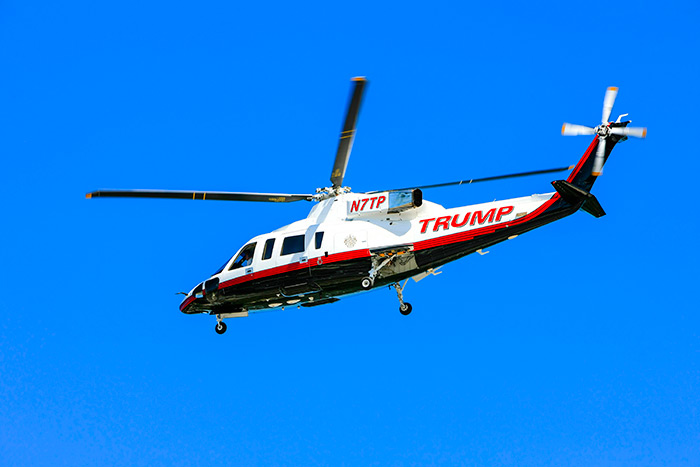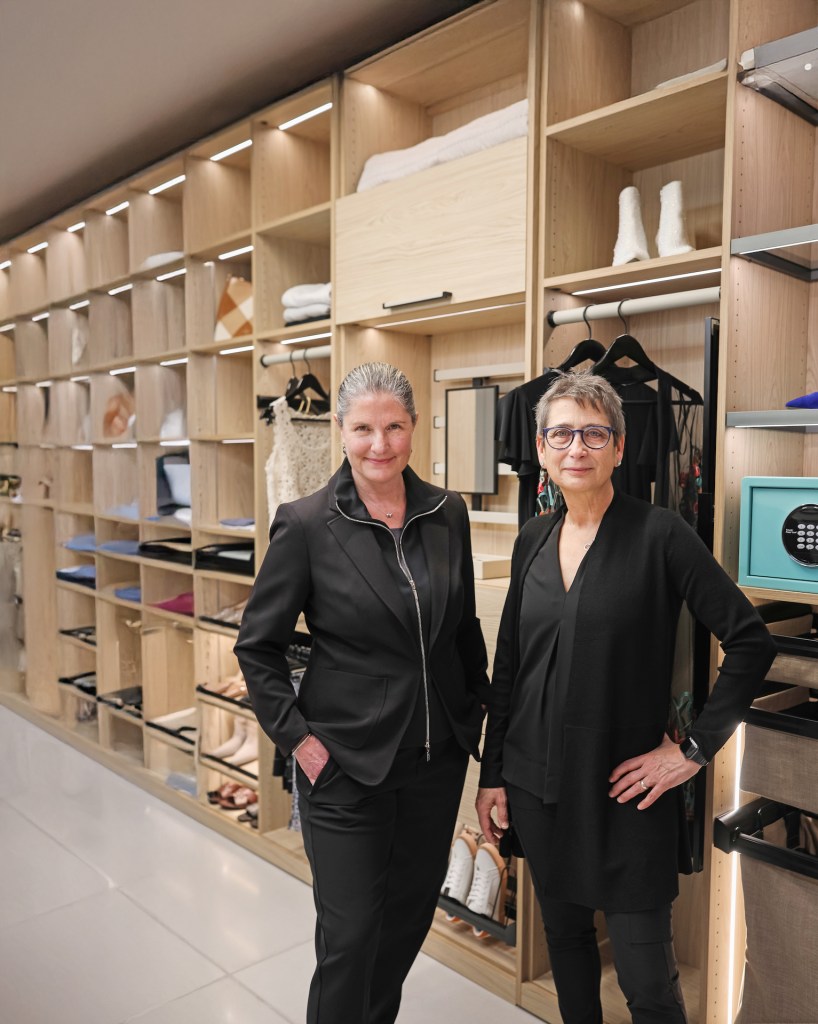Trump's Choppers: From 1989–92 Trump Ran a Hamptons Helicopter Service

Trump Air helicopters began a regularly scheduled service between Manhattan and East Hampton Airport in June of 1989. I remember seeing them out at the airport in that year. They were a stunningly fashionable black with the enormous word TRUMP in gold on each side, and they landed about a hundred feet from the split-rail fence that separated the little tarmac with the shabby little terminal we had back then. Off would come a movie starlet or a fashion model or a Master of the Universe. Then others of that ilk would come out from the terminal, the women holding their hats in place against the wind created by the chopper blades, and with the men in their black suits or summer clothing from the new Ralph Lauren store that had just opened on Main Street.
I would sometimes drive out to the airport to watch the planes take off and land, back then. We’d stand at the railing, my friends and I, and we’d watch this elegant parade for awhile. The choppers would depart. And then the regular private planes would come and go, also planes from the two airlines who had, for five years, competed with each other by flying twin-engine Beechcrafts between East Hampton and the Marine Air Terminal at LaGuardia Airport for the use of the summer people or for some of us locals wanting a quick trip to the city.
The twin-engine Beechcrafts seemed ordinary enough, though they had “East Hampton Airways” or “Long Island Airways” on both sides. During those years, these two airlines had competed with each other, first as charter aircraft and then, beginning about 1986, as regularly scheduled aircraft. I don’t recall the frequency, but it was several times a day. The fare for the Beechcrafts was $69 one-way. For the stunning and dashing Trump helicopters that joined the melee in 1989, the fare was $199. And the choppers landed right at the pad on the East River at East 30th Street.
I recall one instance where fashion models appeared at our terminal for a shoot. Reflection lights were set up. A TRUMP chopper was standing by. They took pouty poses, staring blankly off into the distance while leaning against the split rail. There was such a stunning contrast between what was going on on one side of that split-rail fence and what was happening on the other.
The terminal at that time could not have been shabbier. It was an old beat-up single rectangular one-story building with a sagging roof and old wooden shingles curling against the tarpaper. It had, before it had been an airline terminal, been an army barracks building at the American Army Base at Yaphank, where volunteers got turned into soldiers to fight World War I. When the war ended, the officers announced that any veterans who wanted one of the barracks could have it for $1 and it had to be towed away. One of these became the East Hampton Airport Terminal. This must have been around 1925.
The two competing charter services had competing kiosks inside this little broken-down airport building. The counters each occupied about five feet of floor space and were equipped with ticket forms, schedules, leaflets, telephones, charge card machines, cash drawers, boarding passes and passenger lists. They stood at 90 degrees from each other inside the waiting room and were connected to the outside world by telephone. Two people in uniform manned these kiosks all the time, and they were often seen carefully staring at each other, looking over the heads of those sitting on these ripped sofas waiting for planes to come in and out, while reading old magazines. Trump Air never had a stand. It was too chic for that.
A third wall had a door with a sign on it that read “Bathroom.” It opened on a tiny addition put onto the building, a space three by six feet, that had a toilet, sink and, what with the leaky plumbing, a sagging damp floor. A latch on the inside of the door prevented surprises.
The fourth wall had a door that had a sign on it reading “Operations.” This was another addition to the barracks building. It measured 10 by 12 feet and had originally been built as a chicken coop on a farm not far away. Hauled over one day, it now gave the controllers a little privacy. Nevertheless, from the little waiting room you could often, if you listened carefully, hear the chatter of the planes and the controllers through the wall.
I never got a chance to go to New York on the Trump Air helicopters. However, a New York Times article published at the time shed some light on them. Trump had two 234 Commercial Chinook choppers and three 24-seat Sikorsky S-61 choppers that plied the Hamptons route. He also had a Eurocopter AS332 Super Puma, for special executive flights. The choppers were a nice companion to the elegant and sumptuous Boeing 727 aircraft that Trump had purchased for his new airline, Trump Shuttle. The big 727s went from LaGuardia to Boston and LaGuardia and Washington on the hour. Trump had purchased that route and its aircraft from Eastern Airlines, which had become unsuccessful after a number of good years. Trump gussied up the planes. He believed elegant would sell. It always did. Certainly the Trump Air choppers were doing well, at least at first, taking the wealthy to East Hampton.
The scrawny, homey and broken-down little terminal we had back then now looked very, very out of place with the Trump helicopters coming. And so, in that year of 1989, the Town of East Hampton, which owned the little airport, announced an international architectural competition to build a new terminal. It was run by a prominent East Hampton architectural critic, Alistair Gordon, who’d written books about architecture and was very much part of the design scene at the time. He gave the competition a European name. It was called BEAUX ARCH 89. The winner would win a prize, and then build a new terminal of 4,500 square feet with an observation deck, restaurant, waiting area, baggage room and flight control offices. Also two nice new bathrooms.
That summer, as the blazingly beautiful Trump helicopters flew in and out, entries came into this competition from all over the world. It was astonishing. The competition was featured in architectural magazines, in classrooms at architectural schools, on television programs. Some said this would finally, once and for all, put the Hamptons on the map as a world-class resort. It was already well underway. (The 15 weekly helicopter flights were also putting us on the map.) But this would be the cherry on the top.
Over 60 firms entered this competition, and they all made models of what the terminal would look like. One was designed to look like an airplane propeller lying on its side. Another, from Spain, looked like a castle—it didn’t have a moat, but looked like it could use one. All the entries were put on display upon tables set up at the LTV studio on Industrial Road, and I was appalled at almost all of them. I was particularly appalled at the winner. It was a boxy, single-story flat-roof affair with high windows that flanked ceiling fans that kept the air moving. The entrant said this design was of Moroccan influence.
I objected to this so much I decided to write about it in Dan’s Papers, hoping to disqualify the winner. I wanted something more traditional, more like, for example, the East Hampton Bathing Pavilion. The Hamptons were 17th century Old New England villages. And this was a gateway. Did we need a Moroccan whatever it was?
In the end, a referendum was held about the winner, and the townspeople voted not to build it by a margin of 2 to 1. Instead, five years later, the town constructed what is there today, a re-creation of a more rural affair with a round central rotunda reminiscent of a carousel and similar to the one at the Marine Air Terminal at LaGuardia.
By the time this was built, however, all three of the scheduled airlines were out of business. Frankly, I couldn’t see how three airlines could have competing schedules like this and make any money. Long Island Airlines (formerly the Montauk-Caribbean Airline) returned to offering charters. So did East Hampton Airlines. Both remain as charter operations today.
As for Trump, he ran his helicopter service and his New York shuttle service to Washington and Boston until 1992 when, at the end of that summer, he stopped. He was running into big financial problems at that time. He was skirting bankruptcy in Atlantic City. He had taken out a quarter billion dollar loan for Trump Air. He’d ceded his big yacht to creditors. And he got out of the airline business altogether, never to return.
RELATED: Donald Trump Can’t Do Business in the Hamptons
But then, this past July, he landed one of his TRUMP helicopters at East Hampton Airport and went off to a fundraiser for his presidential campaign at the home of Jets owner Woody Johnson in our town. According to several reports, he had to leave the fundraiser a little early. The airport curfews were in effect and he had to get out before them.
By the way, as I mentioned, my wife and I, during those three years, sometimes took scheduled air services from whichever of the two twin-engine aircraft schedules matched our needs. This was around 1990 and 1991.
The planes themselves had a capacity of about 17. A pilot and co-pilot wearing headsets sat up front. The flights regularly took 40 minutes in the air. But sometimes, when things backed up over LaGuardia, the flights could take an hour and a half.
One of the most beautiful memories I have of these flights was looking down at the New York skyline. We were waiting to land at LaGuardia and were circling low around and around, over Manhattan for 10 minutes or more. This was particularly spectacular around sunset, when the sun mirrored off the skyscrapers and you could almost feel the needles of the Chrysler Building and the Empire State Building brushing up against the underside of the plane.
You can’t do that today. Not since 9/11.
I recall one occasion when a woman in the back undid her seatbelt, stood and stormed up the aisle to the front to loudly ask the pilot how much longer this was going to be because if it wasn’t soon she would be late for an appointment. The co-pilot tipped the headset nearest her off his ear and told her to get back in her seat. She stood over them for about 30 more seconds, and then, having received no further communication, stormed back.
It seems odd that for that five-year period we had three actual regularly scheduled airline services to New York City, but we did. Indeed there were as many takeoffs and landings back then as there are today, but big noisy aircraft and helicopters were a rarity. Most of the traffic was single-engine or twin-engine planes that just fluttered and buzzed as they came in and out.
Indeed, on Friday evenings in those summers, a lot of wealthy people came out from the city in small planes. I recall standing out on Sagg Beach late one Friday afternoon just before sunset and looking up as these planes, about one every 15 minutes, came in carrying the likes of Andy Sabin, Ron Perelman, Wilbur Ross, Carl Spielvogel and others. Well, that is who I imagined was inside. They were friends of mine who took planes.
Today, about half of all the landings and takeoffs involve enormous blasts of jet engines or the bang-bang chatter of helicopters. At the airport in the summertime it sounds like King Kong vs. Godzilla.
The Town feels they have to control the noise made here. People live nearby. There are newer aircraft on the market that make less noise. But because of the extra expense, you rarely see them. The reason is that though the FAA is supposed to mandate that the aircraft owners buy these newer aircraft, the FAA never pulls the trigger. They also say East Hampton Airport has contracted to be an airport forever, as a result of the contract they signed with the Federal Government in 1990. This matter is going to the Supreme Court.



